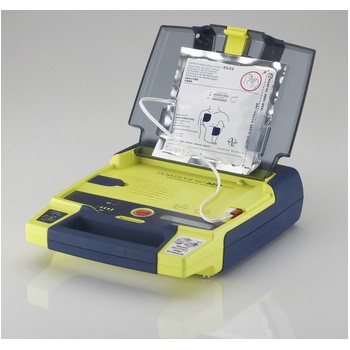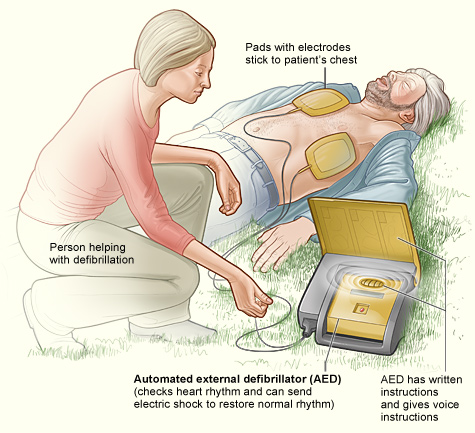AED-Automated External Defibrilator
In recognition that 85 per cent of cardiac arrests occur outside of a hospital, the first legislation of its kind in Canada, the Defibrillator Public Access Act & Regulations, were passed. The regulations require all public places, including facilities such as gyms, arenas, community centers, golf courses, schools, airports, etc. to have defibrillators available for use.
In January 2012, as a result of the new legislation, Pembina Trails School Division installed AED's in all schools and divisional buildings.
The Good Samaritan Protection Act (Bill 214):
The Good Samaritan Protection Act (Bill 214) protects a person who voluntarily provides emergency medical services, aid or advice to a victim of an accident or medical emergency at the immediate scene of the accident or emergency. No liability is posed unless there is clear evidence of gross negligence.
What is an AED?
An automated external defibrillator is a lightweight, battery operated, easy to use, portable electronic device that can be used to treat a victim of cardiac arrest. An AED evaluates a cardiac arrest victim’s heart rhythm, determines if shock is needed and delivers an electric shock through the chest to the heart. Audible and/or visual prompts guide the user through the process.

How to Use an AED
If you see a person suddenly collapse and pass out, or if you find a person already unconscious, confirm that the person can't respond:
- Shout at and shake the person to make sure he or she isn't sleeping. Never shake an infant or young child. Instead, you can pinch the child to try to wake him or her up and shout their name.
- Call 911 or have someone else call 911. If two rescuers are present, one can provide CPR (cardiopulmonary resuscitation) while the other calls 911 and gets the AED.
- Check the person's breathing and pulse. If breathing and pulse are absent or irregular, prepare to use the AED as soon as possible.
- If no one knows how long the person has been unconscious, or if an AED isn't readily available, begin chest compressions, at least 100 compressions per minute for two minutes.
- Before using an AED, check for puddles or water near the person who is unconscious. Move him or her to a dry area, and stay away from wetness when delivering shocks (water conducts electricity).
- Press the on/off button and wait for instructions. The device will give you step-by- step instructions. You'll hear voice prompts and see prompts on a screen.
- Expose the person's chest. If the person's chest is wet, dry it. AEDs have sticky pads with sensors called electrodes. Apply the pads to the person's chest as pictured on the AEDs instructions.
- Place one pad on the right center of the person's chest above the nipple. Place the other pad slightly below the other nipple and to the left of the rib cage.
Automated External Defibrillator
The image shows a typical setup using an automated external defibrillator (AED). The AED has step-by-step instructions and voice prompts that enable an untrained bystander to correctly use the machine.

The image above shows a typical setup using an automated external defibrillator (AED). The AED has step-by-step instructions and voice prompts that enable an untrained bystander to correctly use the machine.
- Ensure the sticky pads have good connection with the skin. If the connection isn't good, the machine may repeat the phrase "check electrodes." If the person has a lot of chest hair, you may have to trim it. (AEDs usually come with a kit that includes scissors and/or a razor.) If the person is wearing a medication patch that's in the way, remove it and clean the medicine from the skin before applying the sticky pads.
- Remove metal necklaces and underwire bras. The metal may conduct electricity and cause burns. You can cut the center of the bra and pull it away from the skin.
- Check the person for implanted medical devices, such as a pacemaker or implantable cardioverter defibrillator. (The outline of these devices is visible under the skin on the chest or abdomen, and the person may be wearing a medical alert bracelet.) Also check for body piercings.
- Move the defibrillator pads at least 1 inch away from implanted devices or piercings so the electric current can flow freely between the pads.
- Check that the wires from the electrodes are connected to the AED. Make sure no one is touching the person, and then press the AEDs "analyze" button.
- Stay clear while the machine checks the person's heart rhythm.
- If a shock is needed, the AED will let you know when to deliver it. Stand clear of the person and make sure others are clear before you push the AEDs "shock" button.
- Start or resume CPR until emergency medical help arrives or until the person begins to move. Stay with the person until medical help arrives, and report all of the information you know about what has happened.
Information courtesy of Heart & Stroke Foundation & National Heart, Lung & Blood Institute


Please provide your question and email address in the fields below.
Your question has been successfully submitted.
CloseThank you.